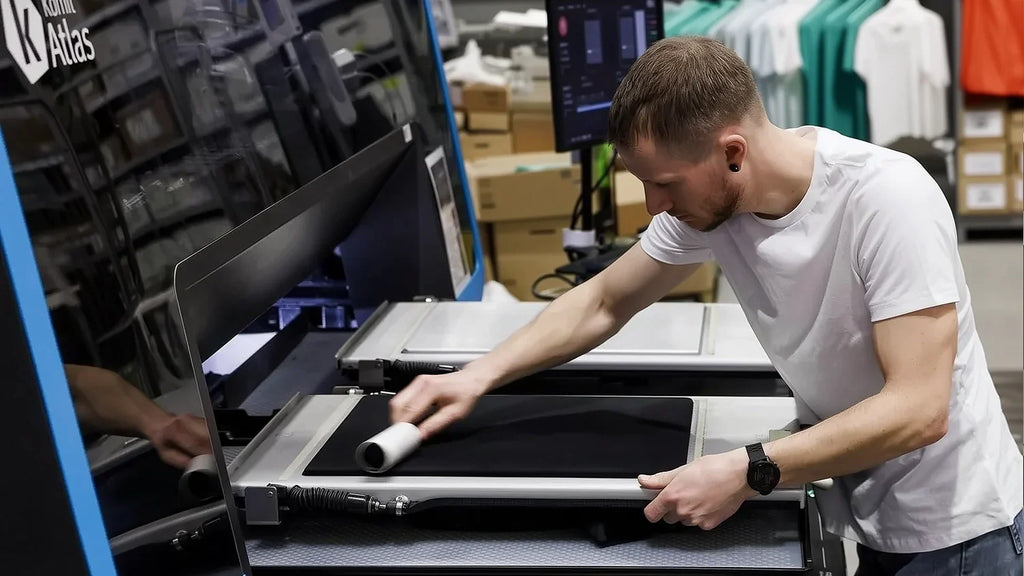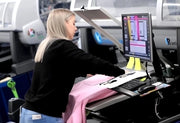⚖️ DTG vs DTF vs Screen Printing: Which Is Best for You?

🧵 A Side-by-Side: Popular T-Shirt Printing Methods
Choosing the right print method can make or break your clothing brand. Whether you’re planning to launch your first collection, exploring t-shirt printing with a logo for business use, or simply looking for t-shirt printing for print-on-demand that suits your design style, understanding the pros and cons of DTG, DTF, and screen printing is essential.
In this guide, we break down the strengths, limitations, and ideal use cases for each technique, helping you find the perfect match for your products, budget, and customers.
🖨️ Step 1: What Is DTG, DTF, and Screen Printing?
Choosing the right t-shirt printing method starts with understanding how each technique actually works. While all three methods apply ink to fabric, the tools, materials, and results differ significantly. Whether you're launching a new clothing line, testing designs for your business, or simply getting high-quality custom t-shirts made, the best method depends on what you’re printing — and what matters most to you: cost, colour accuracy, durability, or flexibility.
DTG (Direct to Garment)
A digital process that prints water-based ink directly into the fabric, typically on cotton garments. DTG is ideal for full-colour, detailed artwork and blends well into the fabric for a soft-touch finish. It’s also one of the most sustainable options — with minimal waste, no harsh chemicals, and OEKO-TEX® certified machinery like our Kornit printers. DTG scales well for both one-offs and large runs, especially for independent brands, eco-conscious labels, and those looking to avoid overproduction.
Best for: Artists, small clothing brands, ethical fashion labels, and environmentally-minded print-on-demand sellers.
DTF (Direct to Film)
Designs are printed onto a heat-transfer film, which is then applied to garments with a heat press. Unlike DTG, DTF works on most fabrics, including polyester and blends — and is especially good for dark colours and sporty styles. It’s also a great choice for DIY or at-home projects with smaller equipment setups. Our DTF transfer sheets let you press designs yourself without buying full machinery.
Best for: Versatile fabric types, t-shirt printing at home, custom gym wear, and heat-applied artwork.
Screen Printing
An older technique that uses layered stencils to apply thick ink onto fabric. While it can produce bold, long-lasting results, it’s better suited for bulk runs of simple graphics due to the setup time and costs. It doesn’t work well for gradients or complex designs and tends to use plastisol inks unless specifically eco-alternatives are requested.
Best for: Basic logos, high-volume orders, uniforms, and straightforward print jobs with minimal detail.
📊 Step 2: Side-by-Side Comparison Table
Now that you’ve got a sense of how each printing method works, here’s a side-by-side comparison to help you weigh the practical differences. From fabric compatibility to setup time and eco-friendliness, this quick reference shows where each method shines — and where it may fall short.
| Feature | DTG | DTF | Screen Printing |
|---|---|---|---|
| Fabric Compatibility | Best on cotton (not suitable for synthetics) | Works on cotton + synthetics | Most fabrics |
| Print Detail | High-res, detailed prints | Crisp, detailed | Sharp, but limited in colour |
| Setup Time | Low | Low | High |
|
Cost per Unit (inclusive of TAX) |
£5.20 to £7.20 (varies: on unit quality) | £20 per sheet (55 x 100 cm sheet) | £2.00 to £7.30 (varies: number of colours and unit quality) |
| Eco-Friendly? | ✅ Yes (water-based inks) | ⚠️ Mixed (film & adhesives) | ❌ Typically uses plastisol |
| Durability | Very Good | Good | Excellent (when applied correctly) |
| Print Feel | Soft | Slight texture (film layer) | Thick or raised |
| Speed | Fast | Fast | Fast |
Screen printing still dominates when it comes to large-scale projects with fewer colours, but DTG is the go-to for high-quality custom t-shirts and low-waste runs. Meanwhile, DTF transfers are rising fast, offering a hybrid solution perfect for t-shirt printing at home, sporty designs, or versatile blanks.
🧪 Step 3: Which Method Is Best for Your Brand?
Your choice of print method depends on your designs, fabrics, and the scale at which you plan to produce them. Whether you’re starting a clothing brand, launching merch, or testing ideas, each method serves a different goal.

For Startup Brands, Artists & Creatives → DTG
DTG is ideal for small brands, creatives, and one-off runs. It prints full-colour t-shirt designs directly onto fabric — no setup costs, no minimum orders — making it perfect for testing ideas and growing at your own pace.
For All Fabric Types & Versatility → DTF
DTF works with cotton, blends, polyester, and more, making it a great choice for brands that offer a variety of options. It's perfect for custom gym wear, bold colours, and sporty styles, and you can apply transfers at home using a heat press.
For Big Bulk Orders & Budget → Screen Printing
For large, simple designs in high volumes (1000+ pieces), screen printing remains the budget-friendly option. Just be aware: it’s slower to set up and not great for complex artwork or gradients.
For Retail-Quality Finish → DTG or Screen Printing
DTG offers a soft-touch, blended look for fashion labels and detailed designs. Screen printing delivers bold, vibrant results that truly stand out — ideal for classic retail merchandise.
For Custom Events & Limited Runs → DTG or DTF
Need event merchandise or short-run prints fast? DTG is print-ready on the spot, while DTF allows you to prep and press in batches — ideal for DIY kits, trials, and time-sensitive drops.
Each method has its moment, and many brands use more than one. Choose what fits your product, then grow from there.
🌿 Step 4: Environmental Considerations
Choosing a printing method isn’t just about price or style — it also affects your environmental footprint. If your brand values sustainability, it’s worth knowing how each print method stacks up in terms of waste, materials, and long-term impact.

For Low Waste & Sustainable Brands → DTG
Direct to Garment (DTG) is widely considered the most eco-conscious print method. It uses water-based inks, no solvents, and avoids the waste-heavy setup of screens or films. Our Kornit DTG printers are OEKO-TEX® certified, producing minimal wastewater and no pre-treatment runoff — perfect for organic cotton clothing or fashion brands built on ethical values. It also supports eco printing methods and is trusted by many independent brands looking to grow responsibly.
For At-Home Printing & Fabric Flexibility → DTF
DTF printing offers great versatility and works on all fabric types — but it does produce some waste. The film sheets and adhesive powders can’t be recycled, and while there’s less pre-print mess than screen printing, it’s not the most sustainable option. Still, for t-shirt printing at home or limited runs with fabric variety, DTF offers a practical balance of convenience and conscience.
For Bulk Orders & Traditional Methods → Screen Printing
Screen printing is the most resource-intensive of the three. It uses chemical washes, water-heavy setups, and plastisol inks — a PVC-based product with poor biodegradability. While eco-friendly screen inks do exist, they’re rarely standard. If you’re producing high volumes or using bulk t-shirt printing for cost reasons, screen printing may fit your budget — but not your sustainability goals.
It’s not about perfection — it’s about making informed decisions. Whether you’re aiming for low-impact printing or simply reducing waste where you can, understanding each method helps you build a better brand.
💸 Step 5: Cost Breakdown (With Examples)
Choosing the most cost-effective print method depends on your order size, garment type, and whether you're doing it yourself or using a print service. Each method has strengths at different volumes, and understanding setup fees, minimums, and per-unit costs will help you avoid expensive mistakes.
| Scenario | DTG (print cost only) | DTF (print cost only) | Screen Printing (print cost only) |
|---|---|---|---|
| 10 Shirts | ~£7.20 each ✅ No setup | ~£8.00 each ✅ Works on any fabric | ~£18.00 each ❌ High setup cost |
| 100 Shirts | ~£6.80 each ✅ Small runs | ~£6.00 each ✅ Mixed fabrics | ~£4.50 each ✅ Bulk discount |
| 1000 Shirts | ~£5.20 each ✅ Scales well | ~£5.00 each ⚠️ Film prep needed | ~£2.20 each ✅ Cheapest per unit |
If you're considering t-shirt printing at home, note that a decent DTG machine can cost thousands, while DTF kits can be assembled with a basic printer and heat press. Screen printing at home requires space, chemicals, and clean-down areas — not ideal for beginners.
In short, for small or mid-size runs, DTG and DTF win. For large volumes where every penny counts, bulk t-shirt printing via screen may still be your cheapest route. But always factor in quality, flexibility, and your brand goals before chasing the lowest price.
🧁 Final Thoughts
There’s no one-size-fits-all when it comes to printing methods. The best choice depends entirely on your design style, your order size, the fabric you're working with, and how much you value things like sustainability, flexibility, or cost-per-unit.
If you're still unsure, don’t worry — you don’t have to figure it all out alone. Talk to our team for honest, jargon-free advice, start testing ideas, or browse our full T-shirt printing service range.
Let us help you bring your clothing brand or merch concept to life — the smart way.
🙋 Frequently Asked Questions
Got questions about t-shirt printing methods? You’re not alone. Here are some of the most common things people ask when deciding between DTG, DTF, and screen printing — answered simply.
🧵 What is the best printing method for small clothing brands?
DTG is often the go-to for independent brands because it’s low-waste, requires no minimum order, and works brilliantly for colourful, artistic designs. It’s ideal for testing ideas and creating one-offs without upfront investment.
🎨 Can I print complex artwork with gradients and fine detail?
Yes — but your method matters. DTG handles full-colour, high-resolution designs best. DTF is also a solid option for sharp detail. Avoid screen printing unless the artwork is simple — it's not great for gradients or photographic images.
🔁 Can I use the same design across different fabrics?
If you're printing on cotton, DTG is great. But if you’re working with polyester, stretch fabrics, or a mix of garment types, DTF gives the best flexibility and consistent results.
🧰 What equipment do I need to start printing at home?
For t-shirt printing at home, a heat press and our pre-printed DTF transfer sheets are enough to get going. DTG machines are expensive and bulky, while screen printing at home requires chemicals, screens, and a clean-down space.
🧺 Which method is the most eco-friendly?
DTG printing wins here — it uses water-based inks and produces minimal waste. Screen printing often relies on plastisol inks and solvents. DTF is improving, but the film and adhesive layer creates more waste.
💰 What affects the price of a printed t-shirt?
Factors include the print method, order size, number of colours, and fabric type. DTG and DTF are usually better for small runs or designs with lots of detail. Screen printing becomes cheaper at very large volumes — but setup fees can make it expensive for small batches.
🚚 How fast is turnaround for each method?
DTF and DTG are both fast — perfect for same-day printing. Screen printing takes longer due to setup and curing time. For rush orders, stick with digital methods.
📦 Can I mix DTG and DTF in one order?
Yes — and it’s common. You might use DTG for cotton-based designs and DTF for synthetics or accessories. Our team can guide you through creating custom clothing using the best mix of methods to suit your budget and garment range.









